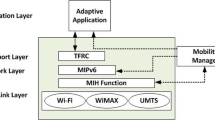Abstract
Up to date the vertical handover (VHO) management across heterogeneous wireless networks has received large attention in recent researches. Independent decisions on different protocol layers responding to the same event may lead to un-optimal operation during VHO over heterogeneous wireless networks. There is demand for solutions capable of managing handovers while ensuring sufficient Quality of Experience for running applications with low signaling overhead. However, user perception has not been handled intensively in context-aware decision algorithms when the Mobile Node undergoes handover. The proposed cross-layer decision framework integrates a set of Quality of Experience based decision-making modules to provide the ability for upper layers to adapt dynamically to fluctuating environmental conditions and optimize the access selection process using a unified signaling messages. This middleware solution manage the signaling coordination actions based on feedback triggers and various policies to reduce false handover indications, compensate for link-layer fluctuations and minimize the impact of mobility. Numerical results highlight enhancements brought by the proposed framework over reference frameworks in terms of perceived quality, handover initiation time and delay constraints.














Similar content being viewed by others
References
Fu, B., Xiao, Y., Deng, H. J., & Zeng, H. (2014). A survey of cross layer designs in wireless networks. IEEE Communications Surveys & Tutorials,16, 110–126.
Chandra, K. H. P. N. S. I. (2018). Optimization of QoS parameters using scheduling techniques in heterogeneous network. Personal and Ubiquitous Computing,22(5), 943–950.
Fernandes, S., & Karmouch, A. (2012). Vertical mobility management architectures in wireless networks: A comprehensive survey and future directions. IEEE Communications Surveys & Tutorials,14(1), 45–63.
Wu, J., Cheng, B., & Wang, M. (2018). Improving multipath video transmission with raptor codes in heterogeneous wireless networks. IEEE Transactions on Multimedia,20, 457–472.
Ko, S., & Chung, K. (2014). A handover-aware seamless video streaming scheme in heterogeneous wireless networks. Annals of Telecommunications,69, 239–250.
Taleb, T., Kashibuchi, K., Leonardi, A., Palazzo, S., Hashimoto, K., Kato, N., et al. (2008). A cross-layer approach for an efficient delivery of TCP/RTP-based multimedia applications in heterogeneous wireless networks. IEEE Transactions on Vehicular Technology,57(6), 3801–3814.
Han, S., Joo, H., Lee, D., & Song, H. (2011). An end-to-end virtual path construction system for stable live video streaming over heterogeneous wireless networks. IEEE Journal on Selected Areas in Communications,29(5), 1032–1041.
Wu, J., Cheng, B., Wang, M., & Chen, J. (2017). Quality-aware energy optimization in wireless video communication with multipath TCP. IEEE/ACM Transactions on Networking,25(2), 2701–2718.
Kwon, O. C., Go, Y., Park, Y., & Song, H. (2014). MPMTP: Multipath multimedia transport protocol using systematic raptor codes over wireless networks. IEEE Transactions on Mobile Computing,14(9), 1903–1916.
Marquez-Barja, J. M., Ahmadi, H., Tornell, S. M., Calafate, C. T., Cano, J. C., Manzoni, P., et al. (2015). Breaking the vehicular wireless communications barriers: Vertical handover techniques for heterogeneous networks. IEEE Transactions on vehicular Technology,64(12), 5878–5890.
Trestian, R., Ormond, O., & Muntean, G. M. (2013). Energy–quality–cost tradeoff in a multimedia-based heterogeneous wireless network environment. IEEE Transactions on Broadcasting,59(2), 340–357.
Wen, Y. F., & Hung, K. Y. (2015). Energy efficiency heterogeneous wireless access selection for multiple types of applications. The Journal of Systems & Software,101, 97–109.
Cacace, F., & Vollero, L. (2006). Managing mobility and adaptation in upcoming 802.21 enabled devices. In Proceedings of the 4th international workshop on Wireless mobile applications and services on WLAN hotspots - WMASH '06, New York
Ramachandran, T., & Sivaradje, G. (2016). Dynamic inter-domain MDS approach with secure seamless handover based on IEEE 802.21 MIH. Wireless Networks,22(6), 1851–1867.
Yoo, S. J., Cypher, D., & Golmie, N. (2010). Timely effective handover mechanism in heterogeneous wireless networks. Wireless Personal Communications,52(3), 449–475.
Skianis, G. L. A. C. (2010). Optimized fusion of heterogeneous wireless networks based on media-independant handover operations. IEEE Wireless Communications,17(4), 78–87.
Akkari, N. (2013). An IMS-based integration architecture for WiMax/LTE handover. Computer Networks,57(18), 3790–3798.
Fu, B., Xiao, Y., Deng, H. J., & Zeng, H. (2013). A survey of cross-layer designs in wireless networks. IEEE Communications Surveys & Tutorials,16(1), 110–126.
Trestian, R., Ormond, O., & Muntean, G. M. (2014). Enhanced power-friendly access network selection strategy for multimedia delivery over heterogeneous wireless networks. IEEE Transactions on Broadcasting,60(1), 85–101.
El Helou, M., Lahoud, S., Ibrahim, M., Khawam, K., Cousin, B., & Mezher, D. (2016). A hybrid approach for radio access technology selection in heterogeneous wireless networks. Wireless Personal Communications,86(2), 789–834.
Han, D., Shin, S., Cho, H., Chung, J. M., Ok, D., & Hwang, I. (2015). Measurement and stochastic modeling of handover delay and interruption time of smartphone real-time applications on LTE networks. IEEE Communications Magazine,53(3), 173–181.
Xu, X., Sun, Z., Dai, X., Svensson, T., & Tao, X. (2017). Modeling and analyzing the cross-tier handover in heterogeneous networks. IEEE Transactions on Wireless Communications,16(12), 7859–7869.
Mohanty, S., & Akyildiz, I. F. (2006). A cross-layer (layer 2 + 3) handoff management protocol for next-generation wireless systems. IEEE Transactions on Mobile Computing,5(10), 1347–1360.
Goudarzi, S., Anisi, M. H., Abdullah, A. H., Lloret, J., Soleymani, S. A., & Hassan, W. H. (2018). A hybrid intelligent model for network selection in the industrial Internet of Things. Applied Soft Computing,74, 529–546.
Author information
Authors and Affiliations
Corresponding author
Additional information
Publisher's Note
Springer Nature remains neutral with regard to jurisdictional claims in published maps and institutional affiliations.
Rights and permissions
About this article
Cite this article
Al Emam, F.A., Nasr, M.E. & Kishk, S.E. Collaborative cross-layer framework for handover decision in overlay networks. Telecommun Syst 73, 189–203 (2020). https://doi.org/10.1007/s11235-019-00604-5
Published:
Issue Date:
DOI: https://doi.org/10.1007/s11235-019-00604-5




